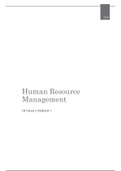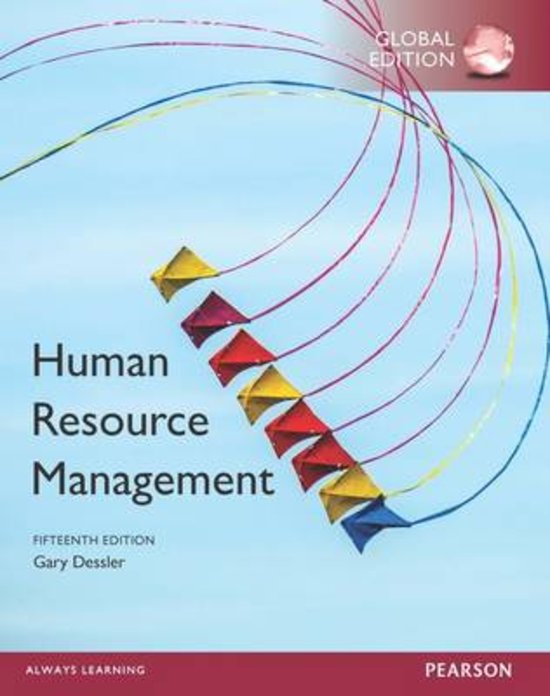2019
Human Resource
Management
IB YEAR 2 PERIOD 1
,CONTENT
Introduction to Human Resource Management 2
Job Analysis and Talent Management Process 7
Personnel Planning and Recruiting 10
Employee Testing and Selection 14
Interviewing Candidates 19
Training and Developing Employees 22
Performance Management and Appraisal 29
Managing Careers and Retention 33
2
,INTRODUCTION TO HUMAN
RESOURCE MANAGEMENT
WHAT IS HUMAN RESOURCE MANAGEMENT?
Human Resource Management: process of acquiring, training, appraising, and compensating
employees, and attending to their labor relations, health and safety, and fairness concerns
- Concepts and techniques managers need to perform:
- Conducting job analyses (determining the nature of each employee’s job)
- Planning labor needs and recruiting job candidates
- Selecting job candidates
- Orienting and training new employees
- Managing wages and salaries (compensating employees)
- Providing incentives and benefits
- Appraising performance
- Communicating (interviewing, counseling, disciplining)
- Training employees, and developing managers
- Building employee relations and engagement
- Managers should know about:
- Equal opportunity and affirmative action
- Employee health and safety
- Handling grievances and labor relations
- HRM is important to all managers:
- Avoid personnel mistakes
- Improve profits and performance
- You may spend some time as an HR manager
- HR for small businesses: you may end up as your own HR manager
- Line and staff aspects of HRM:
- Authority: right to make decisions, direct other’s work, and give orders
- Line Authority: traditionally gives managers the right to issue orders to other
managers or employees
- Staff Authority: gives manager the right to advise other managers or employees
- Line Manager: manager who is authorized to direct the work of subordinates and is
responsible for accomplishing the organization’s tasks
- Staff Manager: manager who assists and advises line managers (e.g. purchasing or
human resource management)
- Line manager’s HRM responsibilities:
- Placing the right person in the right job
- Starting new employees in the organization (orientation)
- Training employees for jobs that are new to them
- Improving the job performance of each person
3
, - Gaining cooperation and developing smooth working relationships
- Interpreting the company policies and procedures
- Controlling labor cost
- Developing the abilities of each person
- Creating and maintaining departmental morale
- Protecting employees’ health and physical conditions
- Typical jobs:
- Recruiters: maintain contacts within community and perhaps travel extensively to
search for qualified job applicants
- Equal Employment Opportunity (EEO) Representatives or Affirmative
Action Coordinators: investigate and resolve EEO grievances, examine
organizational practices for potential violations, and compile and submit EEO reports
- Job Analysts: collect and examine information about job duties to prepare job
descriptions
- Compensation Managers: develop compensation plans and handle the employee
benefits program
- Training Specialists: plan, organize, and direct training activities
- Labor Relations Specialists: advise management on all aspects of union-
management relations
- New approaches to organizing HR:
- “Shared services” (or “transactional”) arrangements: establish centralized HR units
whose employees are shared by all the companies’ departments to assist the
departments line managers in HR matters
- Specialized corporate HR teams: assist top management in top-level issues such as
developing personnel aspects of the company’s long-term strategic plan
- Embedded HR teams: HR generalists assigned to functional departments
- Centers of expertise: specialized HR consulting firms within the company
TRENDS SHAPING HRM
- Workforce demographics and diversity trends
- Trends in how people work: service jobs, on-demand workers, human capital
- Globalization trends
- Economic trends
- Technology trends: social media, mobile applications, gaming, cloud computing, data
analytics
4






